Why has the PRG report been ignored?
What ever happened to the Periodic Review Group's report on superannuation?
Wednesday, September 29th 1999, 12:00AM

The Periodic Review Group (PRG) report, which was the first six-yearly review of New Zealand's superannuation environment, is an important document as it addressed the vital issue of how to integrate public and private provision, namely New Zealand Superannuation with voluntary savings.
No matter what happens with the issues of affordability of NZ Super and whether to have a regime based on compulsion, tax incentives or voluntary savings, the integration issue is imperative as the state pension, while likely to decrease in size over time, isn't going to disappear overnight.
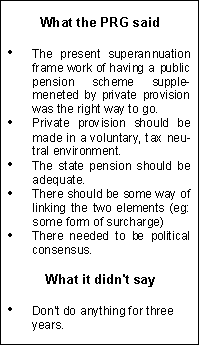
The integration issue was also thrown into sharp relief after the last election by the coalition Government's action's in abolishing the surcharge.
Despite it being a major issue it has all but been ignored, even by the other major super report of the past 12 months, the Investment Savings and Insurance Association (ISI) Report on Savings: A Wake-Up Call.
In its final report which was released in December the PRG outlined five alternatives for integrating private provision and public provision, and it signalled its support for some form of targeting the pension. In essence it argued there needed to be some sort of superannuation surcharge.
As PRG member and Auckland University economics lecturer Susan St John says: "There needs to be some sensible replacement for the surcharge before it's too late."
The five examples the PRG presented boil down to a range of three options: a universal benefit, a part-universal/part-targeted benefit and a targeted (income and asset tested) benefit.
PRG chairman and chartered accountant Jeff Todd says the examples haven't been fully costed, nor are they detailed, rather they illustrate the trade-offs which will be required if the public and private portions of superannuation are to be integrated.
Each chart gives a snapshot of the projected disposable incomes of people aged 65 or over in 2020. The shaded area of the chart shows the private and public components of that income by decile on an income earned basis. The chart shows the middle ranked person in each decile. The dark shaded area shows the net amount of superannuation, thus giving a rough visual impression of fiscal cost.
Todd says it is important New Zealanders discuss the options and reach a consensus about how the superannuation scheme should be structured.
"The debate is not about which option saves the most money, but ultimately some fiscal saving will be important," St John says. "An option that looks like it saves a lot of money may have some nasty downsides."
EXAMPLE A: A universal amount indexed to wage growth
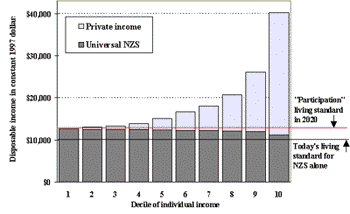
This example reflects the current system after the surcharge has been removed and the wage floor triggered. It emphasises the universal pension being part of a social contract, with eligibility being a right of citizenship.
The distribution of income is very skewed with the bottom 80 per cent of those over 65 having less than $10,000 of other income. The net amount of NZ Super the top decile reduces, and is 78 per cent of the net pension of the bottom decile illustrating the richer people in retirement still get a significant piece of the state pension.
EXAMPLE B: An amount indexed to wage growth, delivered through the tax system and abated away at higher income levels.
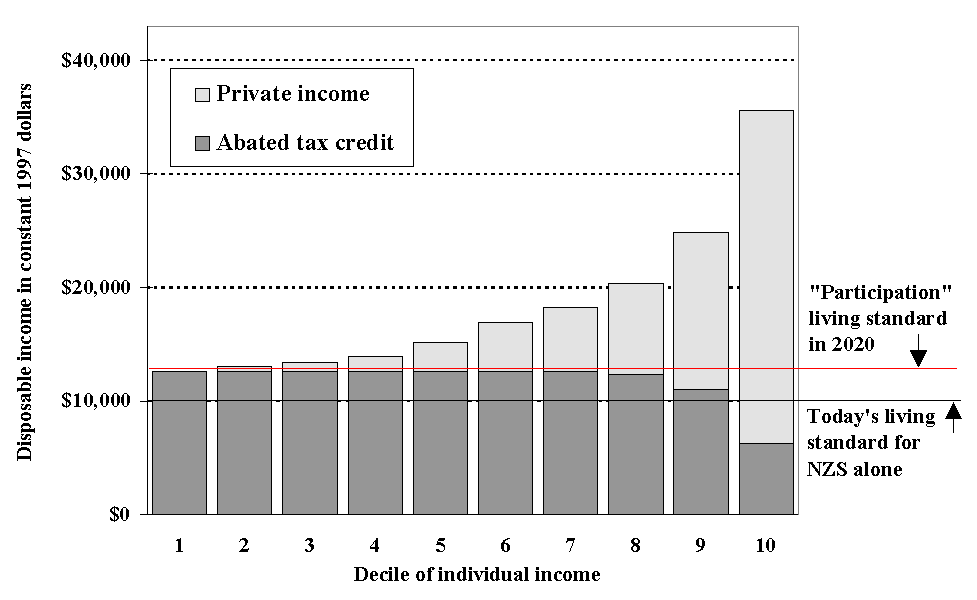
Retired people would receive, as a tax credit, a payment equivalent to New Zealand Superannuation net of tax. It shows increased income redistribution and lowers fiscal cost than example A and the importance of having tax based, rather than social welfare based pension system.
This option bears a close resemblance to the current system under the surcharge regime. Although the chart does not show it the top five percent lose all of their NZ Super payments.
EXAMPLE C: A universal amount linked to inflation, plus targeted top-ups.
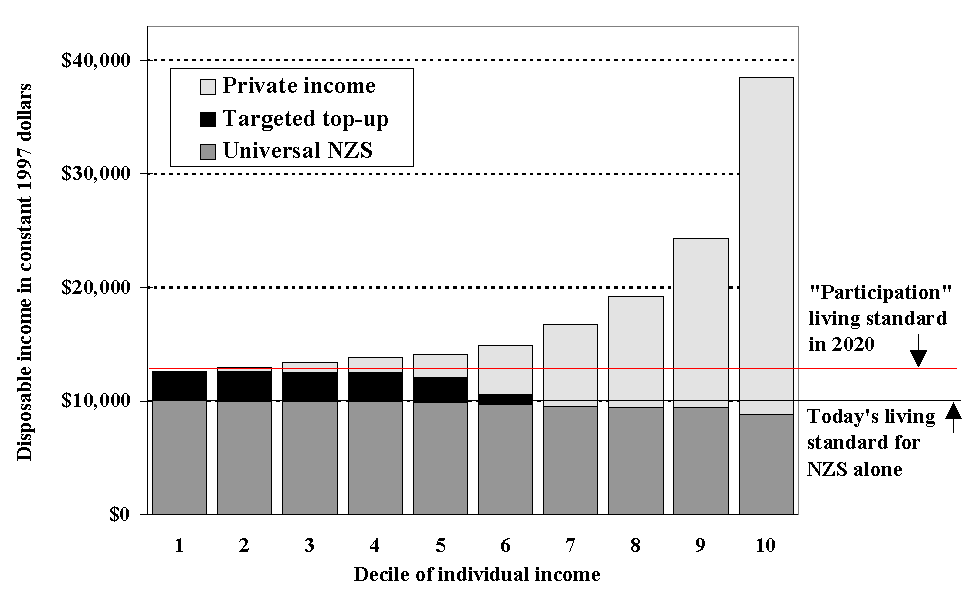
This provides a non-income-tested individual retirement income entitlement at a set level, and people who for reasons such as disability, transport or accommodation, could apply to a top-up or a benefit.
The fiscal costs of this example are lower than in the previous two, and it provides protection for those in difficult circumstances. It provides a lower pension than A, thereby encouraging private provision.
EXAMPLE D: Choice of a low universal pension, linked to inflation, or an income tested age benefit.
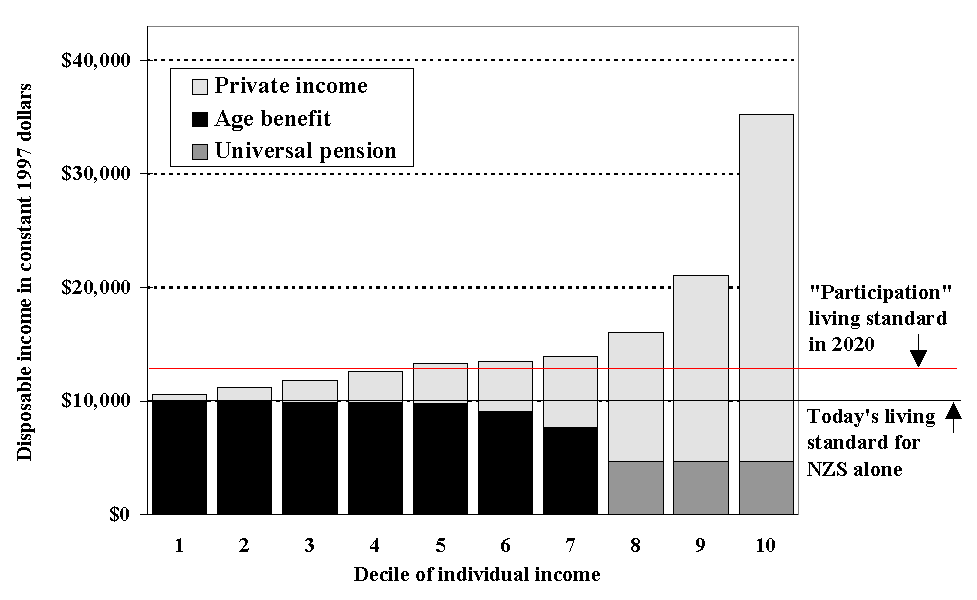
Under this example, people would choose whether to receive the universal pension or be income-tested for an age benefit. It recognises the collective contribution of each generation, but to a lesser extent than example A, while the income tested age benefit would provide a safety net.
This is described as the citizenship/collective insurance model, where the state pension is universal (but half the current level), but not income tested, thereby avoiding administrative burden. The income tested age benefit portion would be tightly targeted and would provide a safety net for those with a low level of private savings.
EXAMPLE E: An income-tested age benefit alone (targeted option)
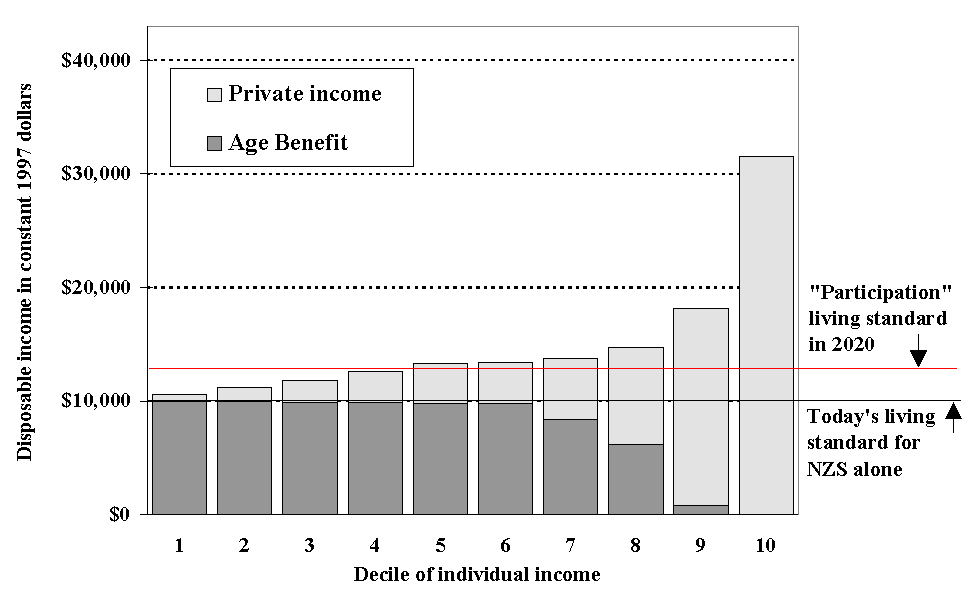
This would provide an income tested welfare benefit for retired people who are unable to provide an adequate retirement income from their own sources. It has the lowest fiscal cost of all the options and emphasis personal responsibility for providing for old age. The role of Government is limited to providing an adequate income to those who are unable to do so as a result of illness, certain caring responsibilities or being unable to obtain employment.
The five options cover the range from providing a universal entitlement to every pensioner through to a benefit where the state would only provide assistance for those in dire need. On a political scale they traverse the whole spectrum of from left to right.
A key element of the debate which hasn't been had is what NZ Super is, is it a universal entitlement (which it is now) or should it be a benefit? On top of that is the following question: what do old people need to live on to satisfy what society agrees is a minimum acceptable standard of living in retirement? This question has been thrown into sharp relief following the Government's recent decision to lower the floor on NZ Super from 65 per cent of the average weekly wage to 60 per cent. Now we have people such as Planit Services director Michael Littlewood saying it should be further lowered to 55 per cent, while political parties such as Labour are saying, if it wins the next election, it would reverse the reinstate the level at 65 per cent.
Despite many of the major questions raised by the PRG report being ignored there has been some progress. For instance the PRG said one of the problems with the review process was the lack of reliable data available to help make assessments. In the past year a steering group on net worth and savings statistics was established and it is due to report to Government soon.
Likewise the Office of the Retirement Commissioner has done research on home equity conversion and the impact of the disclosure legislation on employer sponsored superannuation schemes. On top of this the Government's proposed Superannuation 2000 taskforce will be asked to progress the PRG's recommendations.
| « Compulsory Super: No way to solve super | Labour outlines its super policy » |
Special Offers
Commenting is closed
| Printable version | Email to a friend |


